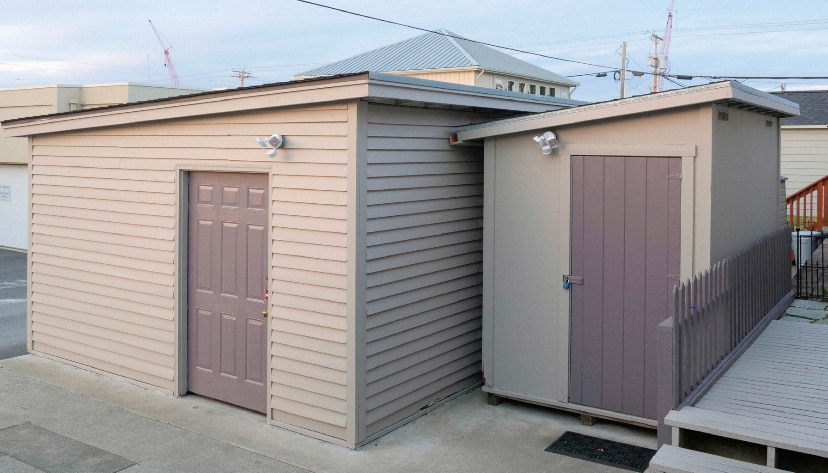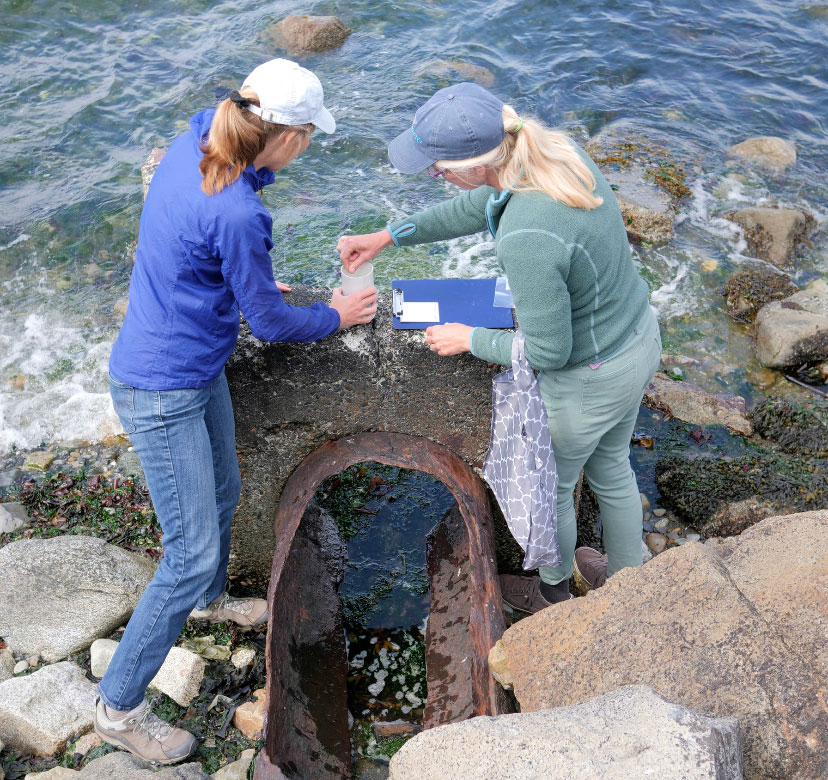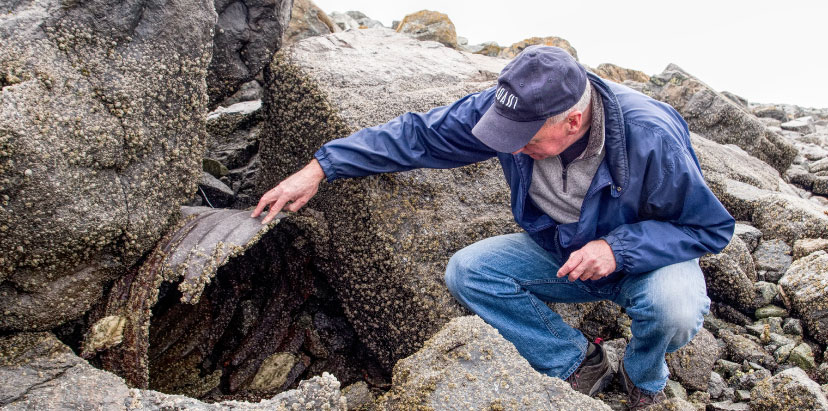A grassroots group of Anacortes retirees seeks to restore Orca habitats in the Puget Sound.
By Aidan Anderson
Orcas, known as Killer Whales, are not actually whales and are in fact a member of the dolphin species.On the island of Fidalgo, nestled in the easternmost inlet of the Puget Sound in Northern Washington, the relentlessly cloudy and bone-chilling weather keeps most people inside their well-insulated coastal residences during the winter months. Nonetheless, a quaint home in downtown Anacortes is bustling with visitors on a cold afternoon in March. Situated just a block from the restaurant district, the house looks like a cozy cottage with its well-kept yard and the aromas of its two vibrant Cherry Blossoms blowing in the sea breeze. The people gathering there, though, mean business.
They come and go, carrying small containers of liquid to the back alley where the grey, seaside home’s back shed has been converted into a workspace. The containers are placed into a machine in the shed. A passerby can hear the sounds of laughter and conversation, the discussion of current events. To the uninitiated, it all seems a little mysterious.
A woman’s voice is heard above the rest. “Would anyone care to stop in for a cup of coffee once you are done with the samples?”
After a while, the group disperses and the moon finds its way through the dense winter clouds shrouding the island. Who are these people? What are they doing with their containers and their machines inside that shed?
They’re trying to save whales, killer whales that is, Orcas to be more precise, which aren’t really whales, actually, but, rather, the largest (by far) member of the dolphin family. They are collecting and analyzing water samples in that shed, keeping an eye on how the urban environment spills into the Salish Sea through stormwater drainage.
Over the past two years, this group of inspired retirees has worked hand in hand with the municipal agencies charged with tracking the water quality of stormwater running through the city’s drains and into Orca habitats via outfalls, or drainage pipes.
Despite the city government keeping records of the water volume going through the stormwater drains, the levels of pollution were not being analyzed. Seeking to correct this, a citizen-led group of 22 amateur researchers, most of them senior citizens and retirees, decided to make it their mission to monitor the City of Anacortes’ stormwater outfalls.
Friends of Skagit Beaches: The Volunteer Stormwater Monitoring Project was born in January 2020. During the course of their work, the group has discovered that 60 percent of the pollution that enters Puget Sound has resulted from poorly managed stormwater outfalls along the coastline. That pollution is believed to be the main culprit in the degradation of the Salish Sea’s Orca habitats and the decline of its resident Orca populations. According to the Washington State Orca Task Force, the resident Orca population has declined by 32 percent since 1995. With only 74 Southern Resident Orcas left in the Salish Sea, the work of grassroots initiatives such as the Friends of Skagit Beaches is even more urgent.
The Friends of Skagit Beaches spent the first six months of its efforts applying for grants in order to fund the purchase of research tools needed to analyze the pollutant levels of the outfalls. In under a year, they managed to attract a privately funded grant of $20,000 from the Rose Foundation, headquartered in San Francisco.
The $20,000 grant, received in 2020, allowed them to get the devices that test for water temperature, conductivity, pH, dissolved oxygen, and turbidity of the seawater at the base of the stormwater outfalls.
Stormwater outfall during heavy rain. Courtesy of Friends of Skagit Beaches
These five parameters are vital for determining the liveability of the environments directly associated with the stormwater outfall. As detailed by Friends of Skagit Beaches: The Volunteer Stormwater Monitoring Project water temperature when compared to the air temperature “indicates a possible unsafe chemical reaction or illicit discharge.” The conductivity of the water highlights “a possible presence of chemicals in the stormwater, like fertilizers.”
The pH of the stormwater runoff will determine how safe the seawater is for the organisms living in it. In order for the water to be categorized as a survivable habitat, the pH must be between 5 and 9 on the pH scale. The preferred pH is 7, a level that provides the most balanced level of water acidity. The level of Dissolved Oxygen will provide the researchers with the information needed to determine whether or not there is sufficient saturation of oxygen bubbles in the stormwater. If there isn’t enough oxygen in the water, marine life cannot be sustained.
The turbidity of the seawater is directly connected to the amount of solids in stormwater. If the sediment concentration is too high the reproductive environments of the fish populations plummet.
Data collected on these parameters from the city’s 79 stormwater outfalls provides the Friends of Skagit Beaches with the information needed to determine which of those are posing the highest threats to the Salish Sea’s Orca population.
Shortly after being awarded the Rose Foundation grant, the Friends of Skagit Beaches set their sights higher on acquiring funding on a federal level. In 2021, a federally endorsed grant governed by The National Fish and Wildlife Foundation became available for research and conservation groups fighting for environmental change in Washington’s rich marine habitats.
The Friends of Skagit Beaches won a $150,000 grant, providing the group with the means to expand their conservation initiative to three more municipalities. These include nearby Bellingham, Oak Harbor, and Port Townsend. These three cities pose high threats to Orca habitats due to their extended coastlines and high quantity of stormwater outfalls.
What do stormwater outfalls have to do with the welfare of Orcas in the Salish Sea?
Stormwater is the number one source of water pollution in Puget Sound and surrounding waterways. The perpetual rainy nature of the Pacific Northwest means that there is a constant flow of pollutants into the waterways, including automotive oil, gasoline, chemical residue from processing plants, and microscopic rubber granules that break away from tires, among other things swept into the storm drains.
Stormwater is the number one source of water pollution in Puget Sound and surrounding waterways.
These pollutants are direct causes of aquatic habitat destruction. More specifically, the microscopic rubber granules that break away from tires — a preservative to make tires last longer — are made from a concoction of chemicals that is a known killer of Coho Salmon. The salmon are the primary food source of the Southern Resident Orcas that call the Salish Sea home.
Research published by the University of Washington in early December of 2020 detailed the high death toll the Coho Salmon population was facing due to the stormwater runoff that contained the tire preserving chemical. In addition to the tire preservative, any presence of Copper dust in stormwater runoff poses the threat of hindering the Salmon’s ability to smell. Their ability to smell is imperative for their reproductive capabilities as they must find their natal stream, the stream their egg hatched in, in order to lay the next generation of Salmon.
With entire populations of coho salmon threatened by the presence of rubber granules in storm runoff and salmon losing their ability to smell, the primary food source for Southern Resident Orcas is disappearing. With no food source to fall back on, Southern Resident Orcas are being forced to migrate and follow the few salmon populations that are large enough in numbers to sustain these Orcas.
...
We call these 10 monstrosities the Dirty Dozen.
Tim Gohrke, a longtime resident of Anacortes and nature enthusiast, was the inspirational spark behind this grassroots conservation group. The bustling home where bundled-up visitors come and go carrying water samples belongs to him and his wife. Fellow Friends of Skagit Beaches stop by regularly to drop off samples collected from the storm drain outfalls and to analyze data sets. The irrigation and diversion of stormwater are imperative for marine ecosystems’ survival. This goes for seaside communities around the world.
Tim Gohrke with one of the notorious Dirty Dozen. Courtesy of Friends of Skagit Beaches
Gohrke’s cozy beachside cottage has turned into the headquarters and fully operational laboratory for The Friends of Skagit Beaches. By the terms of their National Fish and Wildlife Foundation grant awards for Killer Whale Research and Conservation, they are now also funded to “[establish] baseline conditions for stormwater systems, educate residents about harmful effects of polluted stormwater, engage volunteers to help local governments find and mitigate sources of pollution.” All while improving the natural habitat of the Orca population — regardless of the weather.
Friends of Skagit Beaches back-alley laboratories. Courtesy of Friends of Skagit Beaches
“Each person is assigned four outfalls to collect samples from,” says Gohrke, “This data is then brought to my house downtown to be sequenced in my back-alley laboratory. We have one team member responsible for all of the data input that is collected from each of the outfalls. We are grateful she has taken the task on because her expertise has allowed for our initiative to run smoothly.”
Gohrke and his team must navigate the rough terrain of Anacortes’ rocky beaches to collect their samples. The outfalls can only be directly accessed at low tide, which means the Friends of Skagit Beaches have to be prepared to traverse large patches of mud and slick algae-covered rocks. It is no easy task, but this group of nature lovers is okay to get down and dirty if it means protecting the natural habitat of the region’s most iconic species.
Friends of Skagit Beaches collecting samples from an outfall at low-tide. Courtesy of Friends of Skagit Beaches
Map of the Dirty Dozen
Gohrke says that over the past 18-months, the group has identified 10 that are outfalls responsible for the majority of Anacortes’ stormwater runoff pollution. “We call these 10 monstrosities the Dirty Dozen,” he laughs. “I know a dozen implies there are 12 but we felt the catchy name made the magnitude of their destruction a little easier to cope with.”
The data from these 10-outfalls has continued to show the severity of their pollutant levels. The team has recently identified an outfall where the local Biodiesel Plant is rinsing their equipment and runoff is entering the Salish Sea.
The pollutant levels of this specific outfall are particularly egregious and raise the question of how many more coastal factories’ are not disposing of their waste properly.
...
There is some irony in the fact that SeaWorld is one of the main funders of the grants that Friends of Skagit Beaches and other grassroots environmental groups are using to protect nature.
Gohrke steps out of his home on a sunny Friday afternoon in late March to greet teams that have just finished collecting samples from their respective outfalls. He motions them towards the back alley where they go to input the samples into the sequencing machines and make note of the pollutant levels. Meanwhile, Gohrke’s wife Deb and other Friends of Skagit Beaches wait to sequence their samples and discuss the recent outcomes of the initiative. Their mood is buoyant as they are still celebrating the recent federal grant that will help them expand their initiative beyond Anacortes and across the region.
There is some irony in the fact that SeaWorld is one of the main funders of the grants that Friends of Skagit Beaches and other grassroots environmental groups are using to protect nature. Many know Seaworld for Shamu and its Orca shows. Netflix’s Blackfishdocumented the abuses SeaWorld had committed against these magnificent creatures in the name of a tourist attraction.
Seaworld’s exploitative relationship with the Orcas has roots in the Salish Sea and Pacific Northwest populations where they captured Orcas to put in their exhibitions in the 1970s. Orcas are intensely family-oriented and separation from their family groups, known as pods, creates high amounts of stress that often turn fatal.
In the 1970s, Orcas were at risk of being placed on the federal Endangered Species List. In 2005, Orcas native to the Pacific Northwest were officially deemed Endangered in both the United States and Canada. Perhaps in an attempt to make amends, SeaWorld put up over $900,000 to match the funds for Orca preservation provided by The National Fish and Wildlife Foundation.
Tim Gohrke and his fellow nature enthusiasts took advantage of the funds. They now are able to support three additional research groups monitoring stormwater outfalls and pollution in the Salish Sea, turning their initiative from a group of local retirees into a nationally recognized movement for Orca habitat preservation. They hope their work will result in more frequent sightings of Orcas around the Salish Sea.
Tim Gohrke assesses the condition of an outfall at low-tide. Courtesy of Friends of Skagit Beaches






